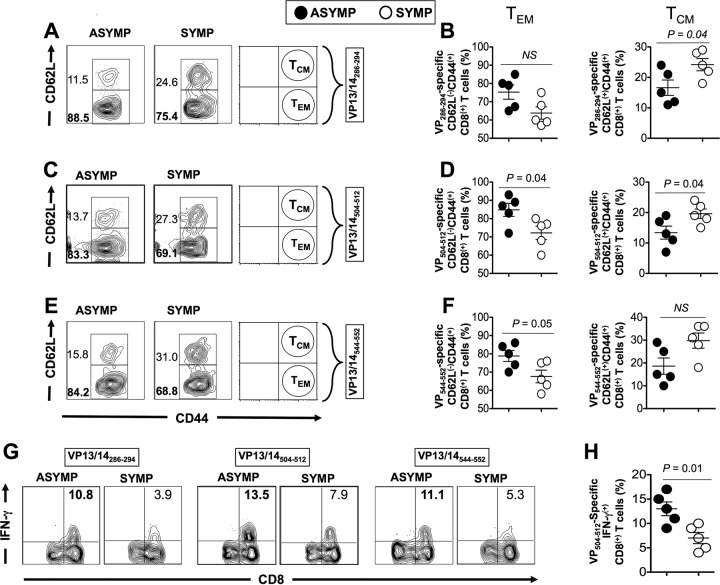FIG 7.
The corneas of protected ASYMP HLA transgenic mice have more VP13/14-specific polyfunctional CD8+ TEM cells than the corneas of nonprotected SYMP mice. Mice were infected with HSV-1 and then segregated into two groups, (i) ASYMP mice and (ii) SYMP mice, on the basis of the clinical score for their ocular herpetic disease. Corneas were harvested from each group on day 9 postinfection, and the frequencies of CD44high CD62Llow CD8+ TEM cells and CD44high CD62Lhigh CD8+ TCM cells specific to the VP13/14286–294, VP13/14504–512, and VP13/14544–552 epitopes were analyzed by FACS using tetramers and specific MAbs, as described in Materials and Methods. (A, C, and E) Representative data on the frequencies of VP13/14286–294-specific (A), VP13/14504–512-specific (C), and VP13/14544–552-specific (E) TEM cells and CD8+ TCM cells detected from the corneas of one ASYMP HLA Tg mouse and one SYMP HLA Tg mouse. (B, D, and F) Average frequencies of VP13/14286–294-specific (B), VP13/14504–512- specific (D), and VP13/14544–552-specific (F) TCM and TEM CD8+ cells detected in the corneas of five ASYMP HLA Tg mice and five SYMP HLA Tg mice. (G) Representative data on the percentage of IFN-γ-positive CD8+ T cells specific to VP13/14286–294, VP13/14504–512, and VP13/14544–552 epitopes detected from ASYMP and SYMP mice. (H) Average frequencies of IFN-γ-positive CD8+ T cells specific to the VP13/14504–512 peptide. The results are representative of those from 2 independent experiments. The indicated P values, calculated using an unpaired t test, show a statistically significant difference between SYMP and ASYMP mice.

